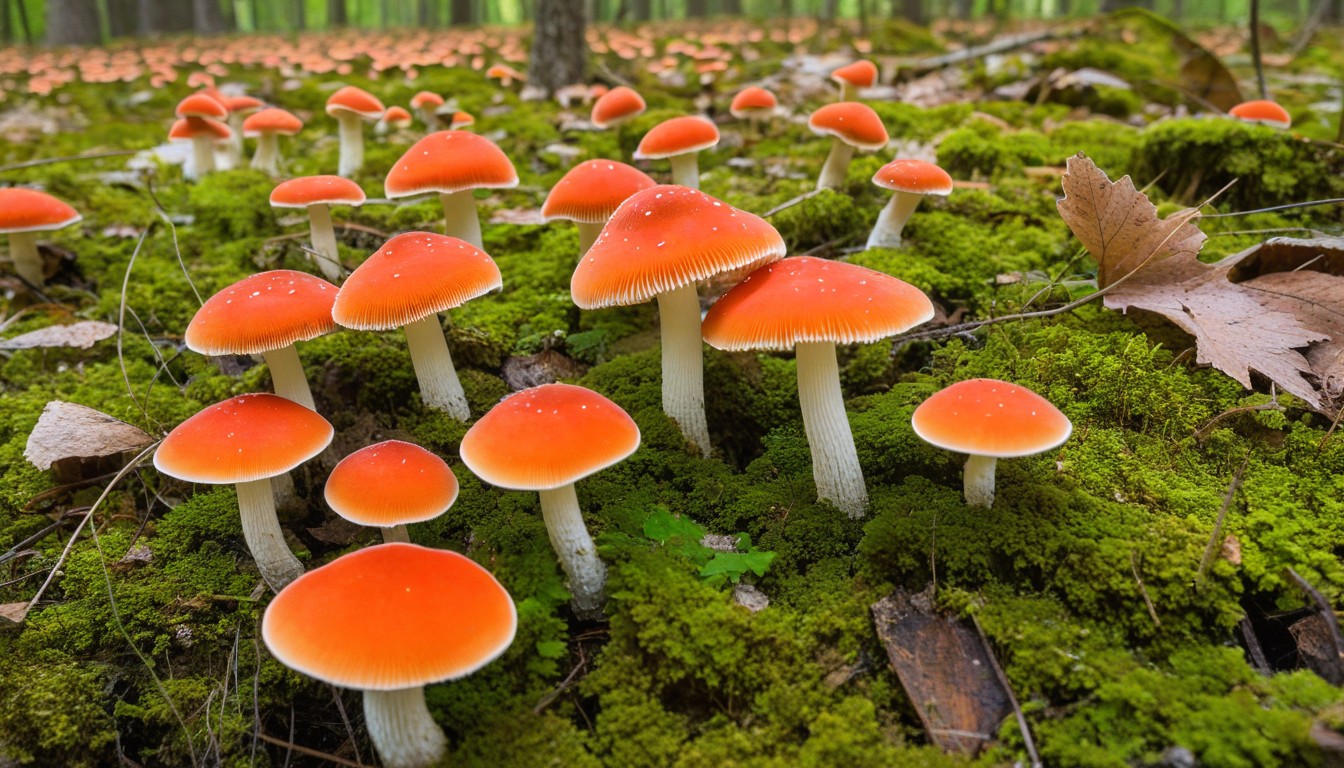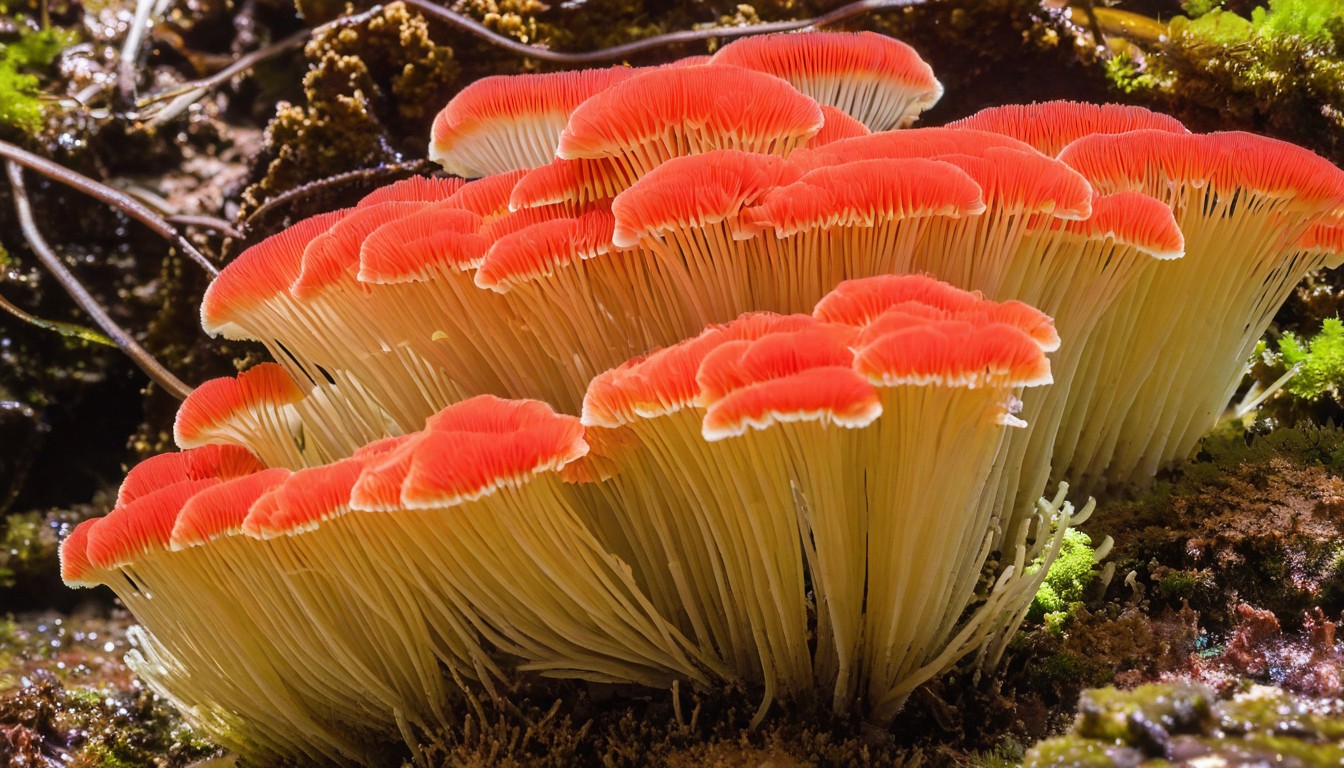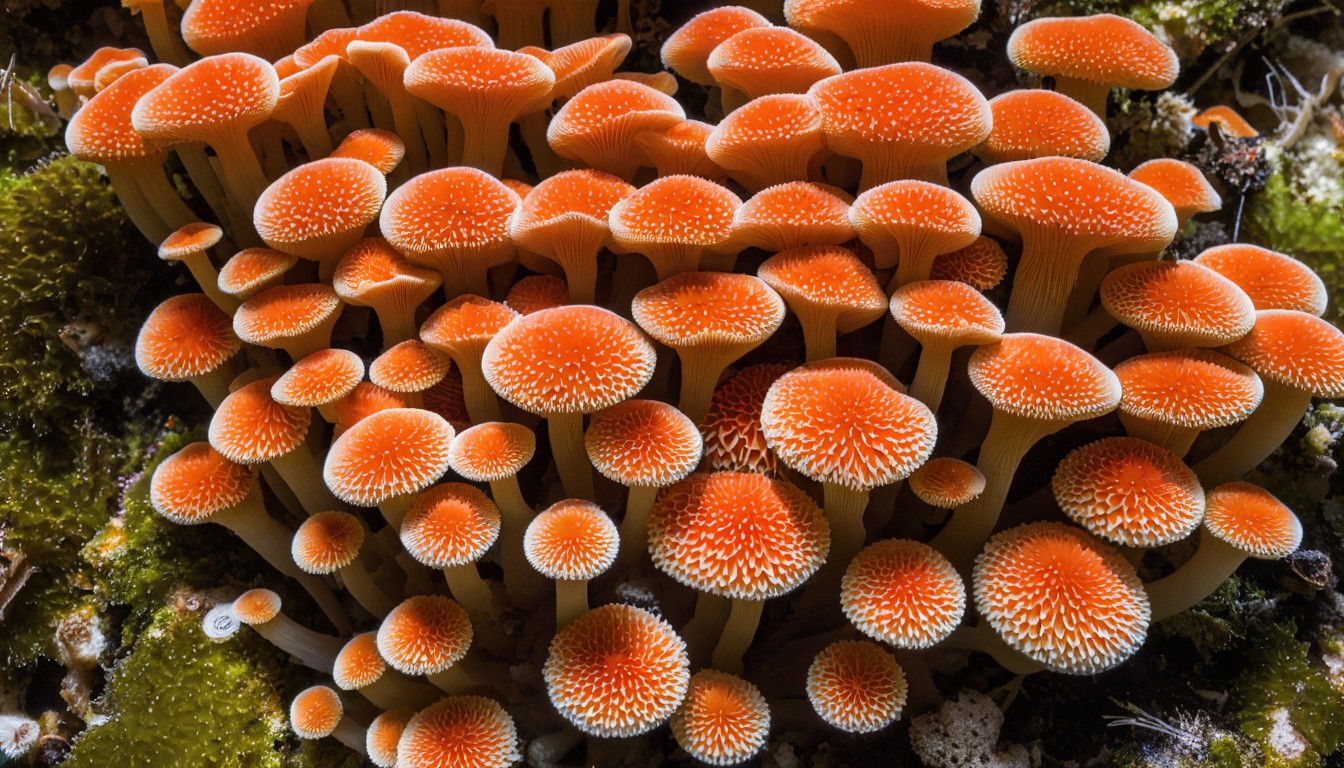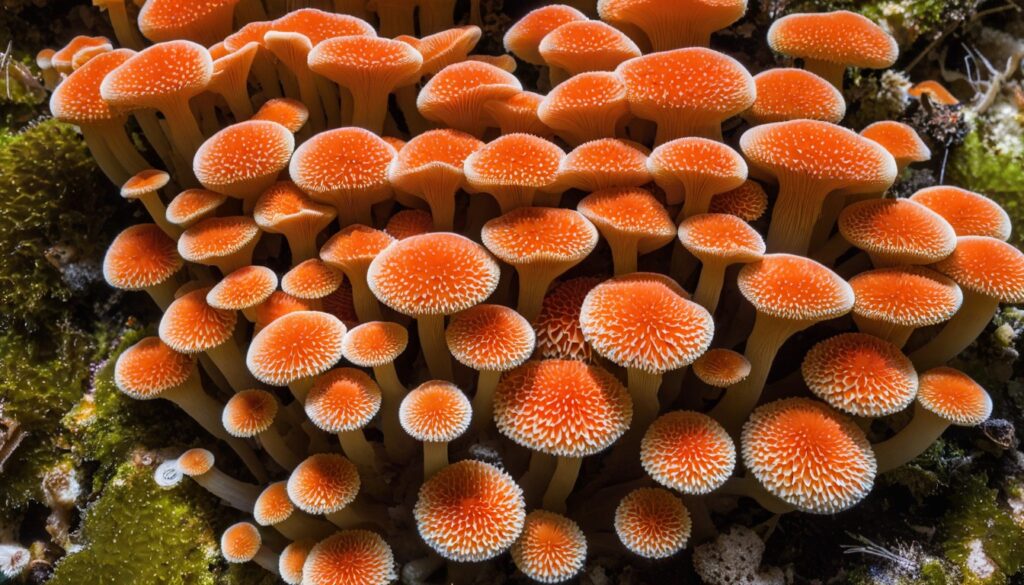Michigan’s untamed forests are home to a variety of fascinating flora and fauna, including a unique group of fungi known as coral mushrooms. Embarking on a fungi foraging adventure in the Great Lakes State is an exciting way to explore these mystical and intriguing fungi.
In this article, we’ll take a closer look at the world of coral mushrooms in Michigan, from their characteristics and identifying features to their culinary and medicinal uses. We’ll also delve into their ecological and cultural significance, as well as the importance of conservation efforts to protect these fascinating fungi.
Key Takeaways:
- Coral mushrooms are a group of fascinating fungi found in Michigan’s wilds.
- They come in various shapes, sizes, and colors, making them unique and intriguing to both foragers and photographers alike.
- Coral mushrooms are not only delicious in the kitchen, but they also provide a variety of potential health benefits when used in traditional medicine.
- These fungi play an important role in forest ecosystems and are an integral part of Michigan’s biodiversity.
- Conservation efforts are necessary to preserve the habitats of coral mushrooms and their fellow flora and fauna.
What Are Coral Mushrooms?
Coral mushrooms are a type of fungi that are easily identified by their unique shapes and colors. These organisms are found throughout Michigan’s wilds and are a popular target for foragers and nature enthusiasts alike.
Coral mushrooms are classified as Basidiomycota fungi and are characterized by their branching, tube-like structures that are reminiscent of coral formations. These fungi come in an array of colors, including vibrant oranges, yellows, and reds, as well as more subdued shades of white and gray.
One of the distinguishing characteristics of coral mushrooms is the texture of their flesh, which is typically tough and fibrous. This makes them less desirable for culinary use compared to other types of fungi such as chanterelles or morels.
Despite their toughness, coral mushrooms play an important role in forest ecosystems as decomposers, breaking down organic matter and releasing nutrients into the soil. They also have symbiotic relationships with trees, exchanging essential nutrients and compounds for carbohydrates via their mycelial networks.
Coral Mushrooms in Michigan
Michigan’s vast natural landscapes hold a treasure trove of stunning coral mushrooms. These mushrooms belong to the genus Ramaria and are characterized by their branching, coral-like shape, and vibrant colors. The Great Lakes State is home to a wide variety of coral mushrooms, which can be found in different regions of the state at varying times of the year.
Region | Season | Variety | Abundance |
|---|---|---|---|
Upper Peninsula | Summer to fall | Ramaria botrytis, R. formosa, R. stricta | Abundant |
Northern Lower Peninsula | Summer to fall | Ramaria subbotrytis, R. araiospora, R. aurea | Somewhat abundant |
Southern Lower Peninsula | Fall | Ramaria botrytis, R. stricta, R. flava | Occasional |
The upper peninsula of Michigan offers an ideal habitat for coral mushrooms, with its cool temperatures, rich soil, and ample rainfall. In contrast, the lower peninsula predominantly harbors coral mushrooms during the fall season when the weather is cooler and wetter. You can expect to find a range of coral mushroom species in these regions, with varying degrees of abundance.
It is crucial to note that coral mushrooms are not only visually mesmerizing but also play a crucial ecological role in Michigan’s forest ecosystems. Therefore, it is essential to forage responsibly and sustainably while respecting the environment that these fascinating fungi call home.
Identifying Coral Mushrooms

Identifying coral mushrooms can be a challenge, but having a keen eye for their key features and visual cues can help distinguish them from other types of fungi. Look for the following characteristics:
- Branching structure: Coral mushrooms have a distinctive branching structure, resembling a miniature tree or coral formation. The branches are often thin and delicate.
- Color: Coral mushrooms come in various hues, including white, yellow, orange, and pink. Some species also feature two or more colors.
- Texture: The texture of coral mushrooms can be smooth, velvety, or scaly, depending on the species.
- Spore-bearing surfaces: The spore-bearing surfaces of coral mushrooms are typically found on the tips of the branches or on ridges along the branches.
To ensure accurate identification, it is also recommended to obtain spore prints. This can be done by placing a fresh, mature mushroom cap on a piece of paper or glass overnight, allowing the spores to drop onto the surface. The color and pattern of the spore print can provide valuable clues to the species of coral mushroom.
Coral Mushroom Hunting Tips
Exploring the wilds of Michigan in search of coral mushrooms can be an exciting and fulfilling experience. Here are some best practices and tips to enhance your coral mushroom hunting adventure:
- Before venturing into the forest, research the regions and seasons in which coral mushrooms are known to grow.
- Wear appropriate clothing, such as long pants, sleeves, and sturdy shoes to protect against ticks, poison ivy, and other hazards.
- Bring along essential tools such as a small knife for harvesting mushrooms, a basket or mesh bag to carry them, and a compass or map to assist with navigation.
- Practice responsible forest exploration techniques, such as leaving no trace, by avoiding damaging vegetation and respecting wildlife habitats.
- Be cautious when handling coral mushrooms, some varieties can be toxic. Use gloves to avoid direct contact.
- Collect samples of coral mushrooms for identification purposes only. Leave them in their natural habitats after identification, and don’t disturb the forest floor.
- Remember to follow safety precautions such as informing someone of your whereabouts, being mindful of your surroundings, and sticking to well-traveled paths wherever possible.
Exploring the world of coral mushrooms in Michigan’s wilds is a thrilling adventure. Following these tips and best practices will ensure your safety while allowing you to enjoy the beauty and diversity of these fascinating fungi. Happy hunting!
Culinary Delights: Cooking with Coral Mushrooms

When it comes to cooking with coral mushrooms, the culinary possibilities are endless. These delicate fungi have a distinctive flavor that can range from mildly nutty to earthy and piquant, depending on the preparation method. Their unique texture makes them suitable for various culinary uses, including salads, soups, stews, and even pasta dishes.
One popular recipe that showcases the flavors of coral mushrooms is the Seared Coral Mushrooms with Garlic and Herbs. To make this dish, sear the coral mushroom caps in olive oil with garlic, thyme, and rosemary until they turn golden brown on each side. Serve them with a sprinkle of salt and lemon juice for a zesty kick.
Another fan favorite is the Coral Mushroom and Gruyere Tart. This savory dish pairs the delicate flavors of coral mushrooms with rich, nutty Gruyere cheese to create an indulgent experience for the taste buds. The tart can be served as an appetizer or a main course, depending on your preferences.
Recipe Name | Preparation Method |
|---|---|
Seared Coral Mushrooms with Garlic and Herbs | Sear the mushroom caps in olive oil with garlic, thyme, and rosemary until they turn golden brown on each side. Serve with a sprinkle of salt and lemon juice. |
Coral Mushroom and Gruyere Tart | Layer sliced coral mushrooms and grated Gruyere cheese on top of a sheet of puff pastry. Bake in the oven at 375 F for 30-35 minutes until the crust is golden brown. Serve hot. |
Whether you are a seasoned gourmet chef or an amateur culinary enthusiast, cooking with coral mushrooms is sure to elevate your dishes to the next level. So go ahead, experiment with these versatile fungi, and see where your culinary imagination takes you!
Coral Mushrooms and Biodiversity
Coral mushrooms play a vital ecological role in supporting biodiversity and maintaining forest ecosystems. As decomposers, they break down organic matter, contributing to the nutrient cycling process in the soil. This, in turn, supports the growth of other plant species and provides food and habitats for a diversity of animal life.
Moreover, coral mushrooms have symbiotic relationships with other organisms, including the trees and plants they grow alongside. For example, some coral mushrooms form mutually beneficial associations with coniferous tree roots, exchanging nutrients and water in a process known as mycorrhizal symbiosis. This facilitates the growth and resilience of these trees in harsh environmental conditions.
Unfortunately, the habitats of coral mushrooms and other fungi are threatened by factors such as deforestation, climate change, and habitat loss. It is essential to preserve these ecosystems and protect the biodiversity that they support. By promoting responsible forest exploration and engaging in conservation efforts, we can safeguard the future of coral mushrooms and the vital ecological roles they play.
Medicinal Properties of Coral Mushrooms

Coral mushrooms have been used for centuries in traditional medicine due to their potential medicinal properties. Recent scientific studies have also investigated their therapeutic potential, revealing promising health benefits.
Health Benefits
Coral mushrooms are rich in antioxidants, which have been linked to a range of health benefits, including reduced inflammation and improved immune function. They also contain beta-glucans, a type of polysaccharide that may help to lower cholesterol levels and improve gut health.
Additionally, coral mushrooms are a good source of essential amino acids, which are crucial for many bodily functions, including muscle repair and immune system support. They also contain important minerals such as potassium, calcium, and magnesium.
Traditional Uses
Throughout history, coral mushrooms have been used in traditional medicine practices to treat a variety of ailments, including digestive issues, respiratory problems, and immune system disorders.
In Chinese medicine, for example, coral mushrooms are believed to have anti-inflammatory and anti-tumor properties, and are often used to treat conditions such as arthritis and cancer. In Japan, they are used to boost the immune system and improve overall health.
Scientific Studies
Several scientific studies have explored the potential health benefits of coral mushrooms. A study conducted in 2015 found that extracts from the mushroom had anti-inflammatory and anti-tumor properties, suggesting that they could have therapeutic potential in cancer treatment. Another study published in 2020 demonstrated that coral mushroom extracts could help to regulate the immune system and reduce inflammation in the body.
While more research is needed to fully understand the medicinal properties of coral mushrooms, these studies suggest that they could hold significant promise as a natural health remedy.
Cultural Significance of Coral Mushrooms
Coral mushrooms have been a part of human culture for centuries, celebrated by various communities for their unique appearance and mystical qualities.
In Chinese folklore, coral mushrooms were symbolically associated with longevity, with the belief that consuming them would lead to a long and healthy life. In Japan, coral mushrooms are thought to have medicinal properties and are often prescribed to combat ailments of the respiratory system.
Native American cultures revered coral mushrooms for their spiritual significance, with some tribes believing that the fungi had the power to aid in communicating with ancestors, spirits, and the divine.
Throughout history, coral mushrooms have been woven into mythologies and traditional beliefs worldwide, cementing their place as a cultural icon.
Conservation Efforts for Coral Mushrooms

Coral mushrooms are a vital part of Michigan’s ecosystem, playing a crucial role in supporting biodiversity and forest ecosystems. However, these fungi are facing various threats, including habitat loss and degradation, climate change, pollution, and over-harvesting.
Efforts are underway to protect coral mushrooms and their habitats through habitat preservation and restoration initiatives. Many organizations and agencies also conduct research and monitoring programs to better understand the threats facing these fungi and develop targeted conservation strategies to address them.
Habitat Preservation
Preserving the natural habitats of coral mushrooms is crucial for their survival. It involves protecting forests from land development, unsustainable logging, and other human activities that can degrade or destroy the ecosystem. Habitat preservation initiatives prioritize the restoration of coral mushroom habitats and promote sustainable forest practices.
Citizen Science
Citizen science plays a critical role in the conservation of coral mushrooms. It involves engaging local communities in monitoring and collecting data on coral mushrooms, helping to advance our understanding of these fungi and their ecological roles.
By participating in citizen science programs, individuals can contribute to vital research efforts and raise awareness of the importance of preserving these fungi for future generations.
Threats | Conservation Measures |
|---|---|
Habitat loss and degradation | Habitat preservation and restoration initiatives |
Climate change | Research and monitoring programs to identify the impacts of climate change on coral mushrooms |
Pollution | Advocacy for sustainable land use practices and pollution reduction measures |
Over-harvesting | Regulation and education programs to promote responsible coral mushroom hunting practices |
Conservation efforts are vital for the survival of coral mushrooms in Michigan and beyond. By working together to protect these fungi and their habitats, we can ensure a healthy and biodiverse ecosystem that benefits us all.
Photography Tips for Capturing Coral Mushrooms
For nature photographers, capturing the beauty of coral mushrooms can be a rewarding challenge. These unique fungi come in various shapes and colors, making them a visually engaging subject for your photographs. Here are some photography tips to help you capture the essence of coral mushrooms:
Composition
When framing your shot, consider the placement of the coral mushrooms within the surrounding environment. Look for interesting angles and perspectives that can create depth and texture in your image. Don’t be afraid to experiment with different compositions, such as close-ups or wide-angle shots, to add visual interest.
Lighting
Lighting can make or break your photograph. In natural light, early morning or late afternoon are great times to shoot as the light is softer and warmer. Be aware of shadows and highlights and how they interact with your subject. If shooting in low light conditions, use a tripod to stabilize your camera and avoid blurry images.
Focus
Ensure that the mushroom you are photographing is in focus, and blur the background behind it, to make the mushroom stand out. To achieve sharp focus throughout the entire mushroom’s body, use a smaller aperture setting (f/8 to f/11) and adjust your shutter speed to the available light.
Depth of Field
Using a shallow depth of field can add a dreamy, ethereal quality to your image, while a deep depth of field can keep the entire mushroom in focus. Experiment with different settings to create the desired effect.
Patience
Capturing that perfect shot may take some time and patience. Be prepared to wait for the right lighting conditions or for the mushroom to move naturally into the perfect composition.
By employing these tips, you can enhance your nature photography skills and capture the beauty of coral mushrooms in Michigan’s wilds.
Conclusion
Exploring coral mushrooms in Michigan’s wilds offers a fascinating adventure for nature enthusiasts and foodies alike. These stunning fungi offer not only gastronomic delights but also ecological significance, medicinal potential, and cultural connections.
While embarking on a fungi foraging adventure, it’s vital to follow best practices for forest exploration and safety precautions to preserve the natural environment for future generations. Citizen science can play a vital role in monitoring and protecting these fungi and their habitats.
Whether you’re a seasoned photographer or just starting, capturing the beauty of coral mushrooms can be an enjoyable experience. Follow our photography tips to improve your skills and document the wondrous shapes and colors of these fungi.
In conclusion, exploring coral mushrooms in Michigan’s wilds can be a fulfilling experience while also fostering a deeper appreciation for the natural world and all that it offers.
FAQ
What are coral mushrooms?
Coral mushrooms are a type of fungi known for their unique characteristics, including their various shapes and colors.
Where can I find coral mushrooms in Michigan?
Coral mushrooms can be found in various regions of Michigan, particularly in the untamed forests of the state.
How can I identify coral mushrooms?
To identify coral mushrooms, look for key features and visual cues that distinguish them from other types of fungi. Additionally, obtaining spore prints can aid in accurate identification.
Any tips for hunting coral mushrooms?
When hunting for coral mushrooms, it’s best to explore forests and bring along essential tools for mushroom hunting. It’s important to also prioritize safety by following proper precautions.
Can I cook with coral mushrooms?
Yes, coral mushrooms are culinary delights that can be incorporated into various recipes to enhance flavors and create unique dishes.
What is the ecological significance of coral mushrooms?
Coral mushrooms play important roles in supporting biodiversity and maintain symbiotic relationships within forest ecosystems.
Do coral mushrooms have any medicinal properties?
Coral mushrooms have been studied for their potential medicinal properties and have been traditionally used in healthcare practices for their health benefits.
Are there any cultural beliefs associated with coral mushrooms?
Coral mushrooms hold cultural significance in folklore, myths, and traditional beliefs, capturing the imaginations of different cultures throughout history.
What conservation efforts are in place for coral mushrooms?
Conservation efforts are focused on protecting coral mushrooms and their habitats, including habitat preservation and citizen science initiatives to monitor these fungi.
Any tips for capturing coral mushrooms in photographs?
For nature photography enthusiasts, we offer tips on capturing the beauty of coral mushrooms, including advice on composition and lighting techniques.

